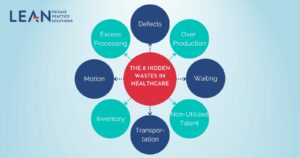The Lean Enterprise Institute defines lean as “a way of thinking about creating needed value with fewer resources and less waste.”
Lean practice is all about constantly innovating to achieve perfect value with zero waste.
And value is always defined by your customer– in our case, our patients.
Lean principles owe their origin to manufacturing, specifically to Toyota, the Japanese car manufacturer.
Through the second half of the 20th century, Toyota founder Sakichi Toyoda and his chief engineer, Taiichi Ohno developed the guiding principles of the Toyota Production System (TPS) with these very goals: reducing waste and perfecting the quest for value.
The idea is to:
![]() First, define or recognize what the customer really wants. In other words, what is the problem they are looking for you to solve. That is the value you provide.
First, define or recognize what the customer really wants. In other words, what is the problem they are looking for you to solve. That is the value you provide.
![]() Then, you define the processes that delivers that value to the customer. This is called value stream mapping or lean process mapping.
Then, you define the processes that delivers that value to the customer. This is called value stream mapping or lean process mapping.
![]() Then you aim to optimize each step in the process for maximum efficiency: ie., using the least resources and with minimum/ideally no errors.
Then you aim to optimize each step in the process for maximum efficiency: ie., using the least resources and with minimum/ideally no errors.
![]() It seeks to simplify processes: the easier the job, the less skilled the worker needs to be and the less the chances of error
It seeks to simplify processes: the easier the job, the less skilled the worker needs to be and the less the chances of error
![]() It focuses on measuring actual progress, not just vanity metrics
It focuses on measuring actual progress, not just vanity metrics
![]() These goals are achieved with constant improvement (the Japanese word for it being “kaizen”).
These goals are achieved with constant improvement (the Japanese word for it being “kaizen”).
The lean philosophy seeks to capitalize on human creativity. It espouses respect for the worker with the *revolutionary idea* that the person doing the job knows how to do it best– as long as they’re given adequate training, responsibility and accountability.
Ultimately, lean principles become
a way of thinking, and then gets ingrained into the behaviors, and therefore the culture of the business.
LEAN IN HEALTHCARE
It may have started in manufacturing but now lean thinking has penetrated pretty much every industry- each field adapting the guiding principles to their needs.
It was Albert Einstein who said, “Absorb ideas from every source”
Lean innovation has found its way into healthcare too- but its just the very beginning. Only certain big institutions have worked on adopting the lean pathway.
The lean philosophy is so aligned to the goals of medicine that I think its a no brainer to adopt more widely- I’d go so far as to say, ubiquitously.
![]() We want to solve our pts problems.
We want to solve our pts problems.
![]() Because there is so much unmet demand, we want to do it fast and efficiently.
Because there is so much unmet demand, we want to do it fast and efficiently.
![]() And because of rising cost of healthcare and falling reimbursements, we want to do it utilizing the least resources.
And because of rising cost of healthcare and falling reimbursements, we want to do it utilizing the least resources.
What’s not to like?
I want to point out something here…. I’ve talked ad nauseum about my version of lean. How I do it.
BUT every lean practice does not need to look like this.
You can be a large practice, with several physicians and multiple locations and staff and still be lean.
Private practices are agile- and therefore, far more amenable to change than behemoths like hospital systems.
So, lean principles are perfect for private practice.
Adopting lean thinking is not capital-intensive or labor-intensive.
You start with observing your practices and making tiny changes.
…Almost like a startup bringing the “minimum viable product” to market and then testing it in the marketplace to decide whether to persevere or pivot.
And this is what I like best about its role in revamping private practice to meet the current challenges in the healthcare landscape.
Privtae practices cannot afford big earth-shattering, expensive Quality Improvement projects that hospital systems sometimes embark upon.
But there’s no evidence that those massive, one-time shake-ups work any better than tiny, continuous, incremental change. Plus they’re so much more doable!
Lean is not synonymous with cost cutting. But the good news is that though cost savings may not be the goal of lean innovation, it certainly is an outcome.
![]() When your patients are happy with the value they’re getting,
When your patients are happy with the value they’re getting,
![]() your processes are efficient and not wasteful,
your processes are efficient and not wasteful,
![]() your employees are engaged and involved:
your employees are engaged and involved:
…… your bottomline is going to reflect it!!




